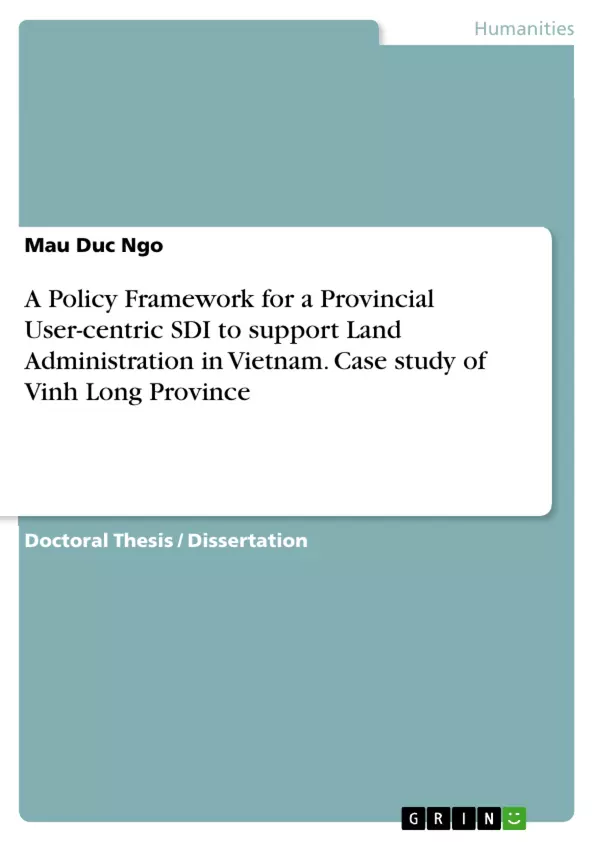The government of Vietnam has received a gradually increasing number of complaints and disputes regarding land administration issues. Significant resources have been invested in related work, including data collection, policy reforms, and technology for land administration. However, there has been very little work directed to policy development for a data-sharing framework. This thesis argues for the development of an Spatial Data Infrastructure Land (SDI) by initially proposing a policy framework as the foundation for such an infrastructure.
The present research employs a multi-method approach with a case-study strategy to investigate the problems and issues in land administration, and the requirements for an SDI to support land administration at the provincial level in Vietnam. The thesis presents a case study based in Vinh Long, a southern province of Vietnam, and draws on this to propose an appropriate policy framework for a user-centric SDI to support land administration at the provincial level. The stakeholder consultations included in-depth interviews with central and local stakeholders, focus group discussions, and a survey by questionnaire of people at the grassroots level of land users.
Inhaltsverzeichnis (Table of Contents)
- Introduction
- Literature Review
- SDI and Land Administration Systems
- Development of SDI Systems
- Land Administration System in Vietnam
- Public Participation and the Right to Information
- Data Sharing and the Importance of SDI
- Research Methodology
- Case Study Strategy
- Data Collection
- In-depth Interviews
- Focus Group Discussions
- Questionnaire Survey
- Data Analysis
- Findings
- Land Administration Problems and Issues
- Lack of Public Participation in Land Administration
- Lack of Transparency in Land Administration
- Limited Accessibility to Land Information
- Stakeholder Perceptions of Land Administration
- Central Government Agencies
- Provincial Government Agencies
- Local Government Agencies
- Land Users
- Requirements for SDI Land
- Policy Framework for SDI Land
- Data Infrastructure Development
- Capacity Building and Training
- Communication and Awareness Raising
- Discussion
- SDI as a Tool for Improved Land Administration
- Implications for Policy and Practice
- Limitations of the Research
- Conclusions
Zielsetzung und Themenschwerpunkte (Objectives and Key Themes)
This PhD thesis aims to address the challenges of limited accessibility to land administration and information in Vietnam, particularly in Vinh Long Province, by exploring the development of a user-centric Spatial Data Infrastructure (SDI) for land administration (SDI Land). It investigates the existing land administration system, stakeholder perceptions, and the requirements for an effective SDI to support land administration in Vietnam.
- The role of SDI in improving land administration and information accessibility.
- The impact of limited accessibility to land information and services on various stakeholders.
- The development of a policy framework for a user-centric SDI Land in Vietnam.
- Stakeholder perspectives and requirements for effective data sharing and utilization.
- The challenges and opportunities associated with implementing an SDI Land in Vietnam.
Zusammenfassung der Kapitel (Chapter Summaries)
The thesis starts with an introduction outlining the research problem and objectives, followed by a comprehensive literature review exploring relevant concepts, including SDI, land administration systems, public participation, and data sharing. The research methodology chapter describes the case-study approach, data collection methods (interviews, focus group discussions, and questionnaire surveys), and data analysis techniques. The findings chapter presents the results of the research, highlighting key problems and issues in land administration, stakeholder perceptions, and the requirements for SDI Land. The discussion chapter examines the implications of the research findings for policy and practice, including the role of SDI as a tool for improved land administration and the challenges associated with its implementation. The conclusion summarizes the research findings, outlining the potential benefits of a user-centric SDI Land in Vietnam and suggesting future research directions.
Schlüsselwörter (Keywords)
The key themes and concepts explored in this thesis include spatial data infrastructure (SDI), land administration, user-centricity, stakeholder engagement, data sharing, policy framework, accessibility to information, and Vietnam. These topics are essential for understanding the challenges and opportunities associated with improving land administration and information accessibility in developing countries.
- Citation du texte
- Mau Duc Ngo (Auteur), 2016, A Policy Framework for a Provincial User-centric SDI to support Land Administration in Vietnam. Case study of Vinh Long Province, Munich, GRIN Verlag, https://www.grin.com/document/370355



